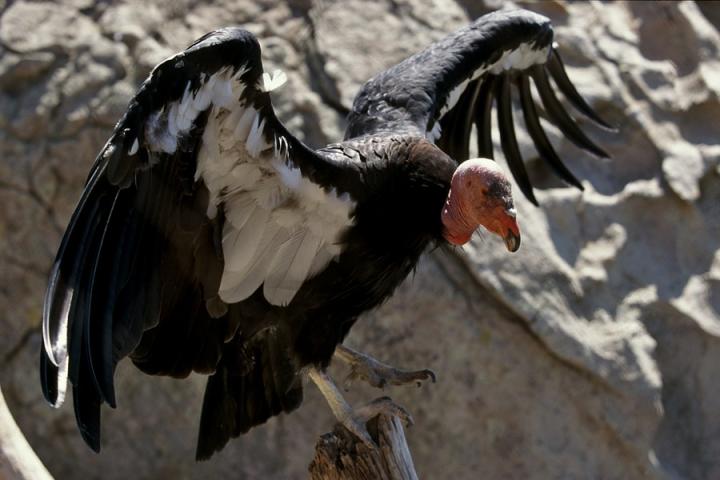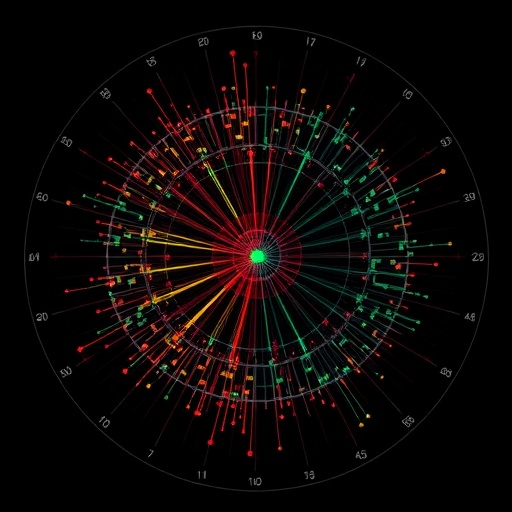First complete genome reveals high genetic diversity despite recent brush with extinction

Credit: Photo courtesy of San Diego Zoo Wildlife Alliance
Despite having been driven nearly to extinction, the California condor has a high degree of genetic diversity that bodes well for its long-term survival, according to a new analysis by University of California researchers.
Nearly 40 years ago, the state’s wild condor population was down to a perilous 22. That led to inbreeding that could have jeopardized the population’s health and narrowed the bird’s genetic diversity, which can reduce its ability to adapt to changing environmental conditions.
In comparing the complete genomes of two California condors with those of an Andean condor and a turkey vulture, UC San Francisco and UC Berkeley scientists did find genetic evidence of inbreeding over the past few centuries, but, overall, a wealth of diversity across most of the genome.
“You need genetic diversity in order to adapt, and the more genetic diversity they (California condors) have, hopefully, the more chance they have to adapt and persist,” said Jacqueline Robinson, a UCSF postdoctoral fellow and first author of a paper about the analysis appearing today in the journal Current Biology. “Our study is the first to begin quantifying diversity across the entire California condor genome, which provides us a lot of baseline information and will inform future research and conservation.”
The health of the bird’s genome is probably due to the species’ great abundance in the past. Robinson and her colleagues, including Rauri Bowie, UC Berkeley professor of integrative biology, used statistical techniques to estimate the bird’s historical population and found that it was far more abundant across the United States a million years ago than even the turkey vulture, America’s most common vulture today. The bird likely numbered in the tens of thousands, soaring and scavenging from New York and Florida to California and into Mexico.
“They have this legacy of high genetic diversity from their former abundance, so I think there is a chance that, with genetic information, we could manage the population going into the future to really maintain the genetic diversity that they do have now and not have any further losses,” Robinson said. “You could even choose individual mates to, in a sense, reverse the inbreeding.”
Co-author Cynthia Steiner, associate director in conservation genetics for the San Diego Zoo Wildlife Alliance, a nonprofit conservation organization affiliated with the San Diego Zoo, agreed that the genomic information will help refine conservation strategies to maintain genetic diversity and reduce inbreeding. Inbreeding may already be causing an increase among wild condors in a lethal form of dwarfism, chondrodystrophy, and leading to an increase among some birds in the number of tail feathers, from 12 to 14.
“We finally have a genomic resource or tool in-hand for the species that will allow understanding the genetic basis of disease and phenotypic traits, such as chondrodystrophy and the 14-tail feather syndrome, and potentially manage these deleterious traits in the breeding program,” Steiner said.
Bowie, an ornithology curator in UC Berkeley’s Museum of Vertebrate Zoology (MVZ), hopes to continue working with the San Diego Zoo to analyze the genomes of all 22 original individual condors in the founding population — the ancestors of all living California condors — to assess the species’ overall genetic diversity. With captive breeding, the aim has always been to mate unrelated condors in order to prevent inbreeding. By generating genome profiles of all individuals of an endangered species, conservationists could more finely tune breeding to weed out any negative health consequences, called inbreeding depression.
“With most endangered species, when you look at their genomes, they have very little genetic diversity left. In other words, they have very little capacity to adapt to change,” he said. “That is definitely not the case with the California condor. With these genome data in hand, maybe there is a way to mitigate chondrodystrophy by cross-breeding certain individuals or finding other ways to help them deal with that.”
Condor’s steady decline
The California condor, Gymnogyps californianus, is considered critically endangered, despite herculean efforts to rescue the species that began in 1987. This involved capturing all wild condors — 27 at that time — and breeding them in zoos. The program’s success was celebrated in 1991 with the reintroduction of captive-bred condors into the wild. Today, more than 300 individuals roam California, Mexico, Arizona and Utah, while another 200 remain in captivity. With a wingspan larger than any other bird in the United States — up to 3 meters, or nearly 10 feet, slightly less than that of the Andean condor (Vultur gryphus), its closest relative — it also is one of the longest-lived birds, often surviving until the age of 60.
Based on the team’s genetic analysis of two California condor genomes over the past million years, condor populations gradually fluctuated downward until a precipitate decline began around the time humans settled the Americas 15,000 years ago. This coincides with the disappearance of large land animals — megafauna — which were likely exterminated by early inhabitants of America between 10,000 and 12,000 years ago. The carcasses of North American megafauna were undoubtedly a major source of food for these carrion-eating scavengers, and condors may have become restricted to the Pacific Coast because they could take advantage of marine mammal carcasses after land animals became less abundant.
The decline accelerated over the last few hundred years with the rising destruction of condor habitat, increased human poaching and persistent lead poisoning from ingested shotgun pellets.
Small population inbreeding
Robinson, who works in the lab of co-author Jeffrey Wall, a professor in UCSF’s Institute for Human Genetics, has focused on genetic studies of small populations where inbreeding increases the incidence of normally rare recessive traits, many of them deleterious. She currently is involved with genetic studies of Mexico’s vaquita, the world’s smallest porpoise, which is critically endangered in its range within the Gulf of California. She co-authored a report last year that found very low diversity in the vaquita’s genome, which is a result of its natural rarity and historically low abundance prior to its recent human-driven population crash, she said.
She embarked on the current study after Bowie collaborated with the San Diego Zoo and the Baylor College of Medicine to produce what he called a “Rolls Royce” version of the condor genome — a high-quality genome that is a rarity for any wild animal and which rivals the quality of the known genomes of the commercial chicken and the laboratory mouse.
“What I mean by a Rolls Royce genome is that it has very few fragments — basically, all the chromosomes are intact,” she said. “With that, you can get a really good assessment of not only how much genetic diversity there is, but how it is distributed across the genome. And that is really helpful if you are trying to find genes that are related to disease or if you are interested in things that are important for enabling condors to do what they do — the adaptive genes.”
Robinson compared Bowie’s condor genome, obtained from the blood of an Arizona condor, and the genome of the San Diego Zoo’s condor with the genomes of the Andean condor and the turkey vulture (Cathartes aura), which had already been sequenced.
Surprisingly, given the California condor’s history, the two genomes contained the highest levels of diversity among all three species.
“Andean condors are somewhat rare, but turkey vultures are extremely abundant, so this result was a bit unexpected, as it doesn’t match current population sizes,” Robinson said. “Genetic diversity is tied to species abundance, so the high genetic diversity in California condor genomes contrasts starkly with the extremely small number alive today.”
Bowie attributes the condor’s success at passing through its near-extinction bottleneck while retaining much of its original genetic diversity to the bird’s long lifespan and slow reproductive rate, which determine its generation time.
“Even though their numbers dramatically plummeted, because of their generation time they hadn’t passed through many generations, so a lot of that genetic diversity was retained,” he said.
The California condor project is one piece of Bowie’s current focus on genetic diversity among all living and extinct vultures. Graduate student Mackenzie Kirchner-Smith is currently analyzing vulture skulls in the MVZ and UC Museum of Paleontology collections to understand past vulture populations, while Bowie has just launched an effort to sequence the genomes of the world’s living species of vulture, in part to understand how the scavenging lifestyle developed independently among three very distinct bird groups.
Robinson hopes to continue with the condor work, as well. Despite having visited condor habitat in the past, she saw her first condor only a few weeks ago when visiting Pinnacles National Park, a popular hangout for condors along the Central California Coast.
“As I was looking at them, I was literally thinking, these almost disappeared during my lifetime. That would have been such a tragedy,” she said. “I would say that we shouldn’t write off any species just because there may only be a few individuals left. The California condor came back from a population size of just 22 individuals.”
Robinson’s co-authors, in addition to Bowie, Steiner and Wall, include David Mindell of UC Berkeley’s Museum of Vertebrate Zoology. The work was funded in part by the National Science Foundation (DEB-1441652).
###
Media Contact
Robert Sanders
[email protected]
Related Journal Article
http://dx.





